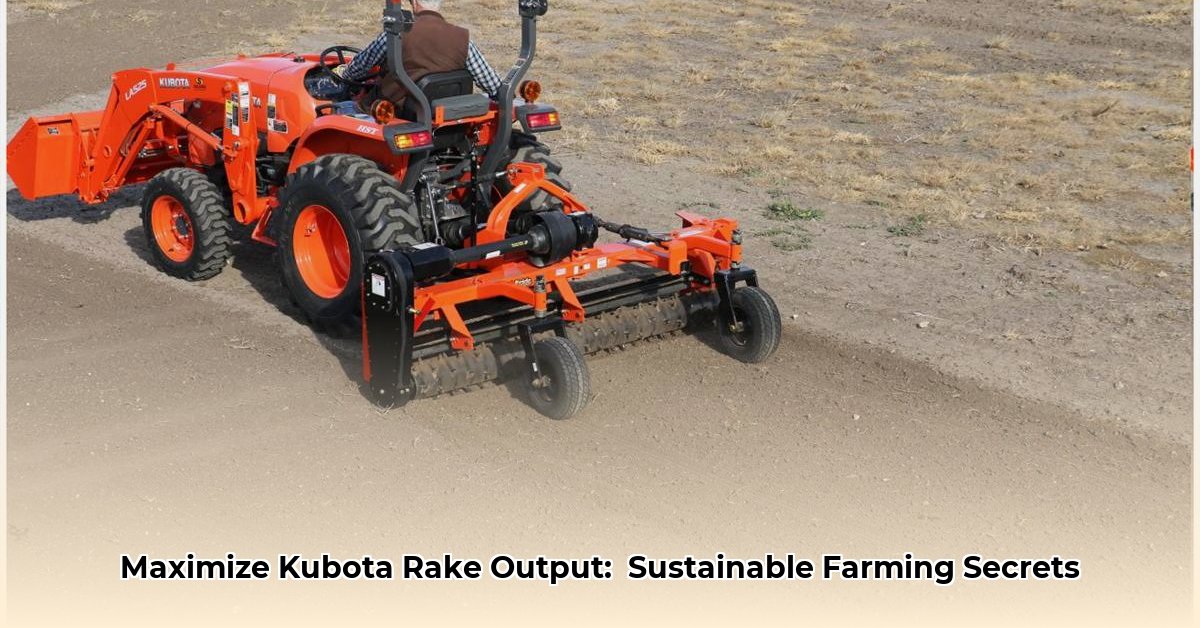
Choosing the Right Kubota Tractor Rake for Your Operation
Selecting the optimal Kubota tractor rake hinges on several key factors influencing both efficiency and sustainability. Ignoring these factors can lead to increased fuel consumption, soil compaction, and ultimately, reduced profitability. What are the critical considerations?
First, assess your farm size. Larger operations demand high-capacity rakes capable of handling significant hay volumes. Smaller farms may find single-rotor models more suitable. Second, consider your terrain. Rugged, hilly landscapes necessitate robust, maneuverable rakes, while flat fields may tolerate lighter-duty models. Third, evaluate the number of rotors. Single-rotor rakes are simpler, while multi-rotor rakes offer increased capacity and speed. Finally, for more detailed information on Kubota rakes, check out this helpful resource. Their expertise ensures the best match between your needs and available models. Remember, a well-suited rake significantly impacts your operation's overall efficiency and sustainability. Don't underestimate the value of professional guidance.
Fuel Efficiency and Environmental Stewardship: Minimizing Your Footprint
Modern Kubota rakes are engineered for fuel efficiency, contributing significantly to both economic and environmental sustainability. The streamlined rotor designs and enhanced hydraulic systems directly translate to reduced fuel consumption per acre. This translates to lower operating costs and a smaller carbon footprint. However, fuel efficiency isn't solely a product of technological advancements. What role does your maintenance play?
Regular servicing and proactive repairs are crucial. A well-maintained rake runs smoothly, optimizing fuel usage and preventing costly breakdowns. This preventative approach optimizes not just fuel efficiency but also the longevity of your machine. A proactive maintenance strategy is a sustainable farming strategy.
Soil Health: Minimizing Compaction for Long-Term Productivity
Soil compaction significantly impacts drainage, crop yields, and overall soil health. Your Kubota rake, when used correctly, can minimize these negative effects. How?
Begin by maintaining correct tire pressure. Under-inflation leads to excessive compaction; over-inflation can damage both tires and soil. Consider using wider tires to distribute weight effectively, reducing compaction pressure. Lastly, avoid raking when the soil is excessively wet. Wet soil is highly susceptible to damage.
Sustainable farming hinges on preserving soil health. By employing mindful raking practices, you protect your land's long-term productivity and reduce the environmental impact of your activities.
Enhancing Hay Quality: The Rake's Contribution to Superior Feed
Consistent, high-quality hay translates directly to healthier livestock and lower feed costs. The Kubota rake significantly influences hay quality through proper windrowing. Evenly formed windrows ensure uniform drying, minimizing spoilage and yielding superior feed. This, in turn, leads to better bale formation, creating denser, easier-to-handle bales, promoting storage efficiency. The quality of your hay is directly linked to the way you use your rake.
Kubota Rake Maintenance: A Guide to Peak Performance and Longevity
Regular maintenance isn't just about extending the useful life of your Kubota rake—it's about maintaining peak efficiency. A well-maintained machine minimizes breakdowns, optimizes performance, and reduces overall operating costs. What are the key components of an effective maintenance program?
Regular Inspections (After Each Use): Immediately following use, perform a thorough visual inspection. Look for loose bolts, damaged parts, or any unusual wear. Addressing minor issues promptly prevents major repairs and extends equipment life.
Lubrication (As Recommended): Adhere strictly to the manufacturer's lubrication schedule. Regular lubrication minimizes friction, reduces wear, and significantly extends the operational life of your machine.
Blade Replacement (Promptly): Worn or damaged blades compromise raking efficiency and may damage the rake itself. Replace them promptly to maintain quality and prevent costly repairs.
Proper Storage (Off-Season): Store your Kubota rake in a clean, dry location during the off-season. This prevents corrosion and reduces the risk of damage from the elements.
A proactive maintenance approach translates to reduced downtime, lower repair costs, and greater efficiency.
Optimizing Rake Efficiency: Proven Techniques for Enhanced Productivity
Beyond maintenance, several operational techniques improve hay-making efficiency. What's your strategy?
Strategic Raking Patterns: Plan your raking routes to minimize turns and overlaps. Efficient routes save time and fuel, directly impacting profitability and sustainability.
Customization of Rake Settings: Adjust settings based on crop type and field conditions. Tailoring your settings to optimal conditions ensures consistent windrows and minimizes hay loss.
Finding the Optimal Ground Speed: Experiment to find the ideal balance – too fast results in uneven windrows, while too slow wastes time and fuel. Finding the sweet spot optimizes both efficiency and fuel consumption.
Prioritizing Safety: Safe Operation of Your Kubota Rake
Operating farm machinery presents inherent risks. Prioritizing safety is non-negotiable.
Pre-Operational Checks: Always conduct a thorough inspection before starting your equipment. Check for any potential issues that could compromise safety.
Personal Protective Equipment (PPE): Consistently wear safety glasses, gloves, sturdy footwear, and other appropriate PPE.
Situational Awareness: Maintain constant awareness of your surroundings, including obstacles, other equipment, and people.
Equipment Condition: Never operate a poorly-maintained rake.
Safety is paramount. It is a non-negotiable aspect of sustainable and responsible farming.
Kubota Rake Models: A Comparative Overview (Hypothetical Data)
The following table presents hypothetical model comparisons. Consult your Kubota dealer for specific model details and features. Remember, this information serves as a general guideline only.
| Model | Rotor Type | Capacity (tons/hour) | Key Features | Best Suited For |
|---|---|---|---|---|
| RG2160 | Single | 5-7 | Lightweight, maneuverable, easy to maintain | Smaller farms, hilly terrain |
| RG2180 | Double | 10-15 | Higher capacity, faster operation | Larger farms, flat terrain |
| RG2200 | Triple | 15-20 | Highest capacity, large fields, heavy-duty | Very large operations, extensive acreage |
Remember to consult your local Kubota dealer for the most accurate and up-to-date information. They will be able to answer all your questions related to the various models of Kubota rakes.
Resources for Further Learning and Support
For additional information and support, contact your local Kubota dealer or visit the official Kubota website. They provide valuable resources, including maintenance guides, troubleshooting tips, and expert advice. Remember, ongoing learning is essential for maximizing your Kubota rake's efficiency and promoting sustainable farming practices.